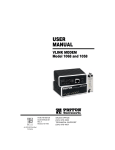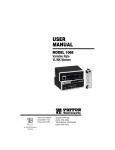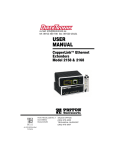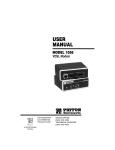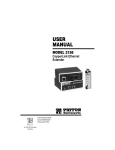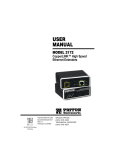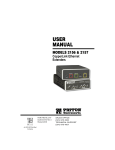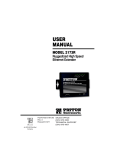Download Patton electronic 1058 Network Card User Manual
Transcript
USER MANUAL VLINK MODEM Model 1058 & 1068 Part# 07MVLINK Rev. A Doc# 058091U Rev. C Revised 3/20/03 An ISO-9001Certified Company SALES OFFICE (301) 975-1000 TECHNICAL SUPPORT (301) 975-1007 CONTENTS 1.0 1.1 1.2 1.3 1.4 1.5 Warranty Information ................................................................. Radio and TV Interference............................................................ CE Notice...................................................................................... FCC Part 68 (DV Version Only).................................................... Industry Canada Notice ................................................................ Service.......................................................................................... 2.0 2.1 2.2 General Information.................................................................... 7 Features........................................................................................ 7 Description.................................................................................... 7 3.0 3.1 3.2 3.3 3.4 Installation................................................................................... 9 Standalone unit installation........................................................... 9 Rack card installation.................................................................. 10 Connecting the Twisted-Pair Line Interface................................ 11 Connecting the 10/100Base-T Ethernet Interface ...................... 12 Connecting the 10/100Base-T Ethernet Port to a Hub ............... 13 Connecting the 10/100Base-T Ethernet Port to a PC (DTE) ...... 13 Connecting the POTS/ISDN line................................................. 13 Connecting Power ...................................................................... 14 3.5 3.6 4 4 4 5 6 6 4.0 4.1 4.2 Configuration (Model 1068 Only) ............................................ Configuring the hardware DIP switches...................................... Configuring DIP Switch S1 ......................................................... Switch S1-1: Ethernet Auto Sense ............................................. Switches S1-2 and S1-4: Data Rate........................................... 5.0 5.1 5.2 Operation................................................................................... 19 Power Up .................................................................................... 19 Front Panel LED Status Monitors ............................................... 19 A A.1 A.2 A.3 A.4 A.5 A.6 A.7 A.8 A.9 A.10 Specifications ........................................................................... 22 LAN Connection .......................................................................... 22 Transmission Line ....................................................................... 22 VDSL Line Rate ........................................................................... 22 VDSL Distance ............................................................................ 22 VDSL Surge Suppressor ............................................................. 22 LED Status Indicators ................................................................. 22 Power Supply .............................................................................. 22 Temperature Range .................................................................... 23 Humidity ...................................................................................... 23 Dimensions ................................................................................. 23 B Model 1058 Series Factory Replacement Parts and Accessories...................................... 24 C MODEL 1068 series Factory Replacement Parts and Accessories...................................... 25 2 15 15 17 17 17 D VLINK Series Interface Pin Assignment ................................. 26 D.1 10/100Base-T Interface .............................................................. 26 RJ-45 .......................................................................................... 26 D.2 VDSL Interface ............................................................................ 26 RJ-45 .......................................................................................... 26 Terminal Block............................................................................ 26 D.3 POTS/ISDN Interface .................................................................. 26 RJ-45 .......................................................................................... 26 E Distance Chart, Based on 24 AWG (0.5 MM) .......................... 27 3 1.0 WARRANTY INFORMATION Patton Electronics warrants all VLINK modem components to be free from defects, and will—at our option—repair or replace the product should it fail within one year from the first date of the shipment. This warranty is limited to defects in workmanship or materials, and does not cover customer damage, abuse or unauthorized modification. If this product fails or does not performs as warranted, your sole recourse shall be repair or replacement as described above. Under no condition shall Patton Electronics be liable for any damages incurred by the use of this product. These damages include, but are not limited to, the following: lost profits, lost savings and incidental or consequential damages arising from the use of or inability to use this product. Patton Electronics specifically disclaims all other warranties, expressed or implied, and the installation or use of this product shall be deemed an acceptance of these terms by the user. Note Conformity documents of all Patton products can be viewed online at www.patton.com under the appropriate product page. 1.1 RADIO AND TV INTERFERENCE The VLINK modem generates and uses radio frequency energy, and if not installed and used properly-that is, in strict accordance with the manufacturer’s instructions-may cause interference to radio and television reception. The VLINK modem has been tested and found to comply with the limits for a Class A computing device in accordance with specifications in Subpart B of Part 15 of FCC rules, which are designed to provide reasonable protection from such interference in a commercial installation. However, there is no guarantee that interference will not occur in a particular installation. If the VLINK modem does cause interference to radio or television reception, which can be determined by disconnecting the unit, the user is encouraged to try to correct the interference by one or more of the following measures: moving the computing equipment away from the receiver, re-orienting the receiving antenna and/or plugging the receiving equipment into a different AC outlet (such that the computing equipment and receiver are on different branches). 1.2 CE NOTICE The CE symbol on your Patton Electronics equipment indicates that it is in compliance with the Electromagnetic Compatibility (EMC) directive and the Low Voltage Directive (LVD) of the European Union (EU). A Certificate of Compliance is available by contacting Technical Support. 4 1.3 FCC PART 68 (DV VERSION ONLY) The Model 1058/1068D is not intended to be connected to the public telephone network. Caution The VLINK modem port is not intended to be connected to the public telephone network. The 1058/1068DV contains a POTS/ISDN connection that can be connected to the public telephone network. Caution This equipment complies with Part 68 of the FCC Rules. Please note the following: This equipment complies with Part 68 of FCC rules and the requirements adopted by ACTA. On the, bottom side of this equipment is a label that contains, among other information, a product identifier in the format US: AAAEQ##TXXXX. If requested, this number must be provided to the telephone company. • Universal Service Order code (USOC) jack: RJ-11C • Facility Interface Code: 02LS2 • Service Order Code (SOC): 9.0F • REN No.: 0.2 A plug and jack used to connect this equipment to the premises wiring and telephone network must comply with the applicable FCC Part 68 rules and requirements adopted by the ACTA. The REN is used to determine the number of devices that may be connected to a telephone line. Excessive RENs on a telephone line may result in the devices not ringing in response to an incoming call. In most but not all areas, the sum of RENs should not exceed five (5.0). To be certain of the number of devices that may be connected to a line, as determined by the total RENs, contact the local telephone company. The REN for this product is part of the product identifier that has the format US:AAAEQ##TXXXX. The digits represented by ## are the REN without a decimal point (e.g., 03 is a REN of 0.3). 5 If this equipment causes harm to the telephone network, the telephone company will notify you in advance that temporary discontinuance of service may be required. But if advance notice isn't practical, the telephone company will notify the customer as soon as possible. Also, you will be advised of your right to file a complaint with the FCC if you believe it is necessary. The telephone company may make changes in its facilities, equipment, operations or procedures that could affect the operation of the equipment. If this happens the telephone company will provide advance notice in order for you to make necessary modifications to maintain uninterrupted service. If trouble is experienced with this equipment, for repair or warranty information, please contact our company. If the equipment is causing harm to the telephone network, the telephone company may request that you disconnect the equipment until the problem is resolved. Connection to party line service is subject to state tariffs. Contact the state public utility commission, public service commission or corporation commission for information. 1.4 INDUSTRY CANADA NOTICE NOTICE: This equipment meets the applicable Industry Canada Terminal Equipment Technical Specifications. This is confirmed by the registration number. The abbreviation IC before the registration number signifies that registration was performed based on a Declaration of conformity indicating that Industry Canada technical specifications were met. It does not imply that Industry Canada approved the equipment. 1.5 SERVICE All warranty and non-warranty repairs must be returned freight prepaid and insured to Patton Electronics. All returns must have a Return Materials Authorization number on the outside of the shipping container. This number may be obtained from Patton Electronics Technical Services at: • Tel: +1 (301) 975-1007 • Email: [email protected] • URL: http://www.patton.com Note Packages received without an RMA number will not be accepted. 6 2.0 GENERAL INFORMATION Thank you for your purchase of this Patton Electronics product. This product has been thoroughly inspected and tested and is warranted for one year for parts and labor. If any questions or problems arise during installation or use of this product, contact Patton Electronics Technical Support at +1 (301) 975-1007. 2.1 FEATURES • Easy to install standalone VLINK modems (no configuration required) • Auto-sensing full or half-duplex Ethernet • Auto-sensing 10/100Base-T • Extends network connections up to 6,000 ft (1.83 km) over 2-wire 24AWG unconditioned lines • Switch selectable line rates up to 16.67 Mbps (Model 1068 only) • 7 symmetric or asymmetric settings via DIP switch (Model 1068 only) • POTS/ISDN splitter on board • Transparent operation • LED indicators for Power, Ethernet Link & Activity, VLINK link & Quality of Line (QOL) • Surge suppression up to 20 kA (8/20 µs) • Available in rack-mount or standalone configurations • Made in the USA 2.2 DESCRIPTION The Patton Electronics VLINK/CO* and VLINK/CP VDSL* modems provide high-speed LAN connections between peered Ethernet LANs, remote PCs, or any other network enabled 10/100Base-T device. Operating in pairs, a VLINK/CO (central office) located at one end of the LAN extension and a VLINK/CP (customer premise) at the other end, these units can automatically forward LAN broadcasts, multicasts, and frames across a 2-wire voice-grade twisted-pair link. The data is passed * Only Models 1058/1068DV/CO and 1058/1068DV/CP have POTS/ISDN splitters on board. 7 transparently (unmodified) through the VLINK modems. The VLINK modems automatically add and delete MAC addresses, only passing packets across the VDSL link that are meant for the remote peered LAN. Figure 1. Typical application The VLINK/CO modem and VLINK/CP modem work together to create a transparent extension between two peered Ethernet LANs. POTS/ISDN calls can be made over a VDSL link without interfering with the data. Figure 1 shows a typical point-to-point application. 8 3.0 INSTALLATION Because the VLINK modem requires no configuration, it can be installed quickly. If you are installing a standalone unit, refer to section 3.1 “Standalone unit installation”. Otherwise, refer to section 3.2 “Rack card installation”. Note If asymmetric transmission or line rates other than 12.5 Mbps are required (Model 1068 only), refer to section 4.0, “Configuration (Model 1068 Only)” on page 15. 3.1 STANDALONE UNIT INSTALLATION Do the following: 1. Connect the line interface between the units (refer to section 3.3, “Connecting the Twisted-Pair Line Interface” on page 11) Note See Figure 2 for the standalone unit’s rear panel arrangements. 2. Connect the Ethernet interface (refer to section 3.4, “Connecting the 10/100Base-T Ethernet Interface” on page 12). 3. Connect the power plug (refer to section 3.6, “Connecting Power” on page 14). Figure 2. VLINK modem standalone rear panel 9 3.2 RACK CARD INSTALLATION The VLINK modem rack card comprised a front card and a rear card.Do the following to install the cards into the rack chassis: 1. Slide the rear card into the back of the chassis along the metal rails. 2. Secure the rear card using the supplied metal screws. 3. Slide the front card into the chassis until you feel resistance as the front card engages the rear card. When that happens, gently push the front card forward until it is fully seated in the card-edge receptacle of the rear card (it should click into place). 4. Secure the front card using the captive fasteners. Note The Model 1001R14 chassis supports “hot swapping” of cards, so it is not necessary to power down the rack when you install or remove a VLINK modem rack card. Figure 3. VLINK modem rack cards 5. Connect the line interface between the units (refer to section 3.3, “Connecting the Twisted-Pair Line Interface” on page 11) Note See Figure 3 for the rack card’s panel arrangements. 10 6. Connect the Ethernet interface (refer to section 3.4, “Connecting the 10/100Base-T Ethernet Interface” on page 12). 3.3 CONNECTING THE TWISTED-PAIR LINE INTERFACE The VLINK modem supports communication between two peer Ethernet LAN sites over a distance of up to 6,000 ft (1.83 km) over 24 AWG (0.5 mm) twisted-pair wire. Note Actual distance and link performance may vary depending on the environment and type/gauge of wire used. Follow the steps below to connect the VLINK modem VDSL interfaces. Note The VLINK modem units work in pairs. One of the units must be a CO (Central Office), and the other unit must be a CP (Customer Premise). It does not matter which end is the CO and which is the CP. The link is always initiated by the CP. As long as the CO is powered on, the CP can establish a link by being powered on or by having its power reset. 1. To function properly, the two VLINK modems must be connected together using twisted-pair, unconditioned, dry, metal wire, between 19 (0.9mm) and 26 AWG (0.4mm). Leased circuits that run through signal equalization equipment are not acceptable. 2. The VLINK modem is equipped with two interface jacks that can be used on the VDSL interface, an RJ-45 or a terminal block. These VDSL interfaces are a two-wire interface. Observe the signal/pin relationships on the VLINK modem's VDSL interface jacks. The RJ-45 connector on the VLINK modem's twisted pair interface is polarity insensitive and is wired for a two-wire interface. The signal/pin relationship is shown in Figure 4. 1 (no connection) 2 (no connection) 1 2 3 4 5 6 7 8 3 (no connection) 4 (2-Wire RING) 5 (2-Wire TIP) 6 (no connection) 7 (no connection) 8 (no connection) Figure 4. VLINK modem (RJ-45) twisted pair line interface. 11 The terminal block connector on the VLINK modem's twisted pair interface is polarity insensitive and is wired for a two-wire interface. The signal/pin relationships is shown in Figure 5. Figure 5. VLINK modem (terminal block version) twisted pair line interface. 3.4 CONNECTING THE 10/100BASE-T ETHERNET INTERFACE The shielded RJ-45 port labeled Ethernet is the 10/100Base-T interface. This port is designed to connect directly to a 10/100Base-T network. Figure 6 shows the signal/pin relationships on this interface. You may connect this port to another Ethernet device via a Type 4 or Type 5 cable that is up to 328 ft long. Figure 6. VLINK modem 10/100Base-T RJ-45 Connector Pinout. 12 Connecting the 10/100Base-T Ethernet Port to a Hub The VLINK modem 10/100Base-T interface is configured as DTE (Data Terminal Equipment), just like a 10/100Base-T network interface card in a PC. Therefore, it “expects” to connect to a 10/100Base-T Hub using a straight-through RJ-45 cable. Figure 7 diagrams the cable wiring for connecting the VLINK modem to a 10/100Base-T hub. Figure 7. Wiring diagram for connecting the VLINK modem to a 10/100Base-T hub Connecting the 10/100Base-T Ethernet Port to a PC (DTE) The VLINK modem 10/100Base-T interface is configured as DTE (Data Terminal Equipment). If you wish to connect the VLINK modem to another DTE devices such as 10/100Base-T network interface card in a PC (or VLINK modems in a back-to-back arrangement), you must construct a 10/100Base-T crossover cable as shown in Figure 8. 10/100Base-T DTE RJ-45 Pin No. 1 (TX+) 1 (TX+) 2 (TX-) 2 (TX-) 3 (RX+) 3 (RX+) 6 (RX-) 6 (RX-) Figure 8. 10/100Base-T crossover cable 3.5 CONNECTING THE POTS/ISDN LINE The RJ-45 port labeled “POTS/ISDN” is the POTS/ISDN interface. A telephone or an ISDN device may be connected to this port and carried over the VDSL line. The units do not need power for the POTS interface to 13 work. The RJ-45 connector in the VLINK modem’s POTS/ISDN interface is wired as shown in Figure 9. 1 (no connection) 2 (no connection) 1 2 3 4 5 6 7 8 3 (no connection) 4 (2-wire RING) 5 (2-wire TIP) 6 (no connection) 7 (no connection) 8 (no connection) Figure 9. VLINK (RJ-45) POTS/ISDN interface 3.6 CONNECTING POWER An external AC or DC power supply is available separately. This connection is made via the barrel jack on the rear panel of the VLINK standalone modem. No configuration is necessary for the power supply (See Appendix B for domestic and international power supply and cord options). DC power (supplied via the power supply jack to the VLINK modem) must meet the following requirements; DC power supplied must be regulated +5VDC ±5%, 1.0A minimum. Center pin is +5V. The barrel type plug has a 2.5/5.5/10mm I.D./O.D./Shaft Length dimensions. The VLINK modem does not have a power switch, so it powers up as soon as it is plugged in. There are no user-serviceable parts in the VLINK modem.Fuse replacement should only be performed by qualified service personnel. Contact Patton Electronics Technical support at (301) 975-1007 for more information. WARNING 14 4.0 CONFIGURATION (MODEL 1068 ONLY) The VLINK modem has eight DIP switches for configuring the unit for a wide variety of applications. This section describes switch locations and explains the different configurations. 4.1 CONFIGURING THE HARDWARE DIP SWITCHES Using a small flat-tip screwdriver, remove the protective cover located on the underside of the VLINK modem (see Figure 10). Figure 10. Removing protective cover Figure 11 and Figure 12 on page 16 show the orientation of the DIP switches in the On and Off positions. 15 Figure 11. Model 1068 standalone modem DIP switch orientation S1 K Mo de m Po w VL er IN K S1 1 2 3 4 IN ON Lin k QO L rn 4 Switch toggle tiv 1 2 ity S1 Push toggle to left for ON position Push toggle to right for OFF position Figure 12. Model 1068 rack card DIP switch orientation 16 1 2 3 4 Ac 3 et Lin k N he O Et ON VL 4.2 CONFIGURING DIP SWITCH S1 DIP switch S1 is where you configure the VDSL line rate, symmetric or asymmetric, Ethernet full auto negotiation capability (100Base-T full or half duplex, 10Base-T full or half duplex) or limited auto sense (only 100Base-T half duplex, 10Base-T full or half duplex). Switch S1-1: Ethernet Auto Sense Use switch S1-1 to configure the unit for full auto sense capability or limited auto sense capability. Full Auto sense capability consists of standard Ethernet Auto sensing (100BaseT full duplex, 100BaseT half duplex, 10BaseT full duplex, and 10BaseT half duplex). Limited Auto sensing capability consists on only auto sensing for 100BaseT half duplex, 10BaseT full duplex, and 10BaseT half duplex. The limited auto negotiation feature is used when an Ethernet device does not comply with IEEE 802.3x (back pressure flow control) at 100M full duplex. Table 1: Ethernet Auto Negotiation Selection Chart S1-1 Setting OFF Full Auto Negotiation (Factory Default) (100 Mbps, Full or Half Duplex) ON (10 Mbps, Full or Half Duplex) Limited Auto Negotiation (100 Mbps Half Duplex) 10 Mbps Full or Half Duplex) Switches S1-2 and S1-4: Data Rate Use switches S1-2 and S1-4 to configure the VDSL line rates. Table 2: Symmetric VDSL Line Rates Selection Chart S1-2 S1-3 S1-4 Symmetric Line Rate ON ON ON ON ON ON OFF OFF ON OFF OFF ON 6.25 Mbps 9.38 Mbps 12.5 Mbps (Factory Default) 16.67 Mbps 17 Table 3: Asymmetric VDSL Line Rates Selection Chart S1-2 S1-3 S1-4 Asymmetric Line Rates DS/US OFF OFF OFF OFF ON ON ON ON OFF 4.17 Mbps/1.56 Mbps (Mode 0) 9.38 Mbps/1.56 Mbps 16.67 Mbps/2.34 Mbps Table 4: Reserved for future use S1-5 S1-6 S1-7 S1-8 OFF OFF OFF OFF Reserved for future use Reserved (Factory Default) 18 5.0 OPERATION Once the VLINK modems are properly installed, they should operate transparently. No user settings required. This section describes reading the LED status monitors. 5.1 POWER UP Before applying power to the VLINK modem, please review section 3.6, “Connecting Power” on page 14 to verify that the unit is connected to the appropriate power source. There are no user-serviceable parts in the VLINK modem.Fuse replacement should only be performed by qualified service personnel. Contact Patton Electronics Technical support at (301) 975-1007 for more information. WARNING 5.2 FRONT PANEL LED STATUS MONITORS The VLINK modem features nine front panel LEDs (five on the rack card) that monitor power, the Ethernet signals, and the VDSL connection. Figure 13 (standalone version) and Figure 14 on page 21 (rack card version) show the front panel LEDs. Table 5 on page 20 describes the LED functions for the standalone model, Table 6 on page 21 describes the LED functions for the rack card. Figure 13. VLINK modem standalone unit front panel 19 Table 5: Front panel LED description for standalone modem LED Power VLINK - Link VLINK - QOL Ethernet - Link Ethernet - COL (Collision) Ethernet - FDx (Duplex) Ethernet - 100M Ethernet - TX Ethernet - RX Description On (green) when power is applied to the unit. Off when no power is applied to the unit. On (green) when the end-to-end VDSL link between the units is established. Off when the link has not been established or when the link fails Flashes yellow at different rates to indicate the amount of error correction taking place on data passing over the VDSL link. This is a normal operating condition and all data is passing correctly over the link even if the link is solidly yellow. However, if the LED is solid yellow and the VLINK Link LED is Off, Off when no power is applied to the unit. On (green) when the 10/100Base-T Ethernet link has been established. Off when the 10/100Base-T Ethernet link has not been established or when the link fails. Flashes yellow to indicate Ethernet collisions are occurring. On (yellow) when in full-duplex Ethernet mode. Off when when operating in half-duplex Ethernet mode. On (yellow) when the link has not been established or when operating in 100-Mbps Ethernet mode. Off when operating in 10-Mbps Ethernet mode. Flashes yellow when data is transmitted from the unit to the LAN. Flashes yellow when data is received at the unit from the LAN. 20 V LIN K VL m de Mo r e w Po VLINK Link K IN Power VLINK QOL ink L OL Q E e th Ethernet Link et rn k n Li Ethernet Activity y vit ti Ac Figure 14. VLINK modem rack card front panel Table 6: Front panel LED description for rack card modem LED Power VLINK modem Link VLINK modem QOL Ethernet Link Ethernet Activity Description Solid GREEN to indicate the unit is powered on. (Active Green) Solid green (ON) to indicate that the end-to-end VDSL link between the VLINK modems is established. The VLINK modem LED is OFF when the link is down. (Active Yellow) Flashes YELLOW to indicate the processor is correcting an error in the data thus preventing the transmission of corrupted data to the Ethernet port. The more error corrections, the more often the LED blinks. If the light remains lit continuously, it means that the VDSL line is noisy—although the data at the Ethernet port remains uncorrupted. Further impairment of the line however, risks having the line fail, as indicated by the green VLINK modem Link LED extinguishing. (Active Green) Solid Green indicates that 10/100Base-T Ethernet link has been established. (Active Yellow) Flashes yellow to indicate Ethernet activity on the VLINK modem’s 10/100Base-T Ethernet port. 21 APPENDIX A SPECIFICATIONS A.1 LAN CONNECTION • Shielded RJ-45, 10/100Base-T, IEEE 802.3 Ethernet • VDSL Connection: RJ-45 and Terminal Block A.2 TRANSMISSION LINE Two-wire unconditioned twisted pair. A.3 VDSL LINE RATE Model 1068—16.67 Mbps, symmetric upstream/downstream. Additional symmetric and asymmetric rates are available via DIP switch settings. Model 1058—Fixed 12.5 Mbps, symmetric upstream/downstream. A.4 VDSL DISTANCE 6,000 ft (1.83 km) at 1.56 Mbps upstream/4.17 Mbps downstream Note Distances depend on selected line rate. A.5 VDSL SURGE SUPPRESSOR Gas tube with maximum current surge: 20 kA (8120 µs). A.6 LED STATUS INDICATORS • Power (Green) • VDSL: Link (Green) & QOL (Red) • Ethernet: Link (Green), Collision (Yellow), Duplex (Yellow), 10/100M (Yellow), Transmit (Yellow), and Receive (Yellow) A.7 POWER SUPPLY Input power: 5 VDC, 1A Power consumption: 450 mA at 5 VDC External AC and DC options: • AC: 120 VAC, 220 VAC, and UI (120–240 VAC) • DC: 12 VDC, 24 VDC and 48 VDC 22 A.8 TEMPERATURE RANGE 32–122°F (0–50°C) A.9 HUMIDITY Up to 90% non-condensing. A.10 DIMENSIONS 1.58H x 4.16W x 3.75D in. (10.6H x 4.1W x 8.8D cm) 23 APPENDIX B MODEL 1058 SERIES FACTORY REPLACEMENT PARTS AND ACCESSORIES Patton Model # Base Models 1058DRC/CO 1058DRC/CP 1058DVRC/CO 1058DVRC/CP 1058D/CO 1058D/CP 1058D-2PK 1058DV/CO 1058DV/CP 1058DV-2PK 07MVLINK-A Power Supplies 08055DCUI 08055-120-5-1 12V-PSM 24V-PSM 48V-PSM Power Cords* 0805US 0805EUR 0805UK 0805AUS 0805DEN 0805FR 0805IN 0805IS 0805JAP 0805SW Description CO VDSL Rack Card; data only CP VDSL Rack Card; data only CO VDSL Rack Card; voice and data CP VDSL Rack Card; voice and data CO VDSL Modem, data only, no power supply CP VDSL Modem, data only, no power supply VDSL MODEM Kit: includes one central office (CO) and one customer premise (CP) Model 1058, data only, no power supply CO VDSL Modem, voice & data, no power supply CP VDSL Modem, voice & data, no power supply VDSL MODEM Kit: includes one central office (CO) and one customer premise (CP) Model 1058, voice & data, no power supply User Manual 100-240VAC (+5V reg. DC/2A) Universal Input Adapter. 120 VAC (+5V reg. DC/1A) Input Adapter 12 VDC Input Adapter 24 VDC Input Adapter 48 VDC Input Adapter American Power Cord European Power Cord CEE 7 United Kingdom Power Cord Australian Power Cord Denmark Power Cord France/Belgium Power Cord India Power Cord Israel Power Cord Japan Power Cord Switzerland Power Cord *Only required with optional UI power supply (08055DCUI) 24 APPENDIX C MODEL 1068 SERIES FACTORY REPLACEMENT PARTS AND ACCESSORIES Patton Model # Description Base Models 1068DRC/CO 1068DRC/CP 1068DVRC/CO 1068DVRC/CP 1068D/CO 1068D/CP 1068D-2PK 1068DV/CO 1068DV/CP 1068DV-2PK 07MVLINK-A CO Variable Rate VDSL Rack Card; data only CP Variable Rate VDSL Rack Card; data only CO Variable Rate VDSL Rack Card; voice and data CP Variable Rate VDSL Rack Card; voice and data CO Variable Rate VDSL Modem, data only, no power supply CP Variable Rate VDSL Modem, data only, no power supply Variable Rate VDSL Modem Kit: includes one central office (CO) and one customer premise (CP) VLINK modem, data only, no power supply CO Variable Rate VDSL Modem, voice & data, no power supply CP Variable Rate VDSL Modem, voice & data, no power supply Variable Rate VDSL Modem Kit: includes one central office (CO) and one customer premise (CP) VLINK modem, voice & data, no power supply User Manual Power Supplies 08055DCUI 08055-120-5-1 12V-PSM 24V-PSM 48V-PSM 100-240VAC (+5V reg. DC/2A) Universal Input Adapter. 120 VAC (+5V reg. DC/1A) Input Adapter 12 VDC Input Adapter 24 VDC Input Adapter 48 VDC Input Adapter Power Cords* 0805US 0805EUR 0805UK 0805AUS 0805DEN 0805FR 0805IN 0805IS 0805JAP 0805SW American Power Cord European Power Cord CEE 7 United Kingdom Power Cord Australian Power Cord Denmark Power Cord France/Belgium Power Cord India Power Cord Israel Power Cord Japan Power Cord Switzerland Power Cord *Only required with optional UI power supply (08055DCUI) 25 APPENDIX D VLINK SERIES INTERFACE PIN ASSIGNMENT D.1 10/100BASE-T INTERFACE RJ-45 • Pin 1: TX+ • Pin 2: TX• Pin 3: RX+ • Pin 6: RX• Pins 4, 5, 7, 8: no connection D.2 VDSL INTERFACE RJ-45 • Pin 4: RING • Pin 5: TIP • Pins 1, 2, 3, 6, 7, 8: no connection Terminal Block See Figure 5 on page 12. D.3 POTS/ISDN INTERFACE RJ-45 • Pin 4: 2-wire RING • Pin 5: 2-wire TIP • Pins 1, 2, 3, 6, 7, 8: no connection 26 APPENDIX E DISTANCE CHART, BASED ON 24 AWG (0.5 MM) Symm Line Rate (DS/US) Distance in feet (km) 6.25 Mbps 9.38 Mbps 12.5 Mbps 16.67 Mbps 4,500 (1.37) 4,150 (1.26) 4,000 (1.22) 3,300 (1.00) Asymm Line Rate (DS/US) Distance in feet (km) 4.17 Mbps/1.56 Mbps (Mode 0) 9.38 Mbps/1.56 Mbps 16.67 Mbps/2.34 Mbps 6,000 (1.83) 5,500 (1.68) 5,000 (1.52) Note Model 1058 is fixed at 12.5 Mbps, 4,000 ft (1,220 m). 27 Notes _________________________________________________________ _________________________________________________________ _________________________________________________________ _________________________________________________________ _________________________________________________________ _________________________________________________________ _________________________________________________________ _________________________________________________________ _________________________________________________________ _________________________________________________________ _________________________________________________________ _________________________________________________________ _________________________________________________________ _________________________________________________________ _________________________________________________________ _________________________________________________________ _________________________________________________________ _________________________________________________________ _________________________________________________________ _________________________________________________________ _________________________________________________________ Copyright © 2003 Patton Electronics Company All Rights Reserved. 28





























